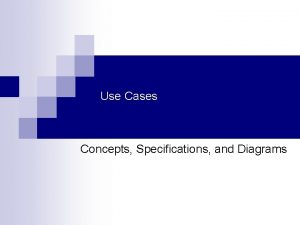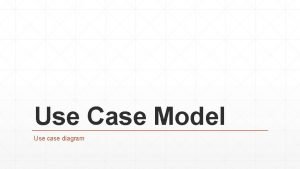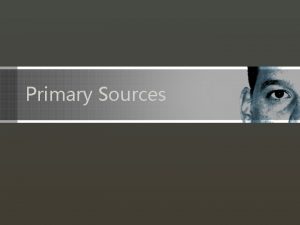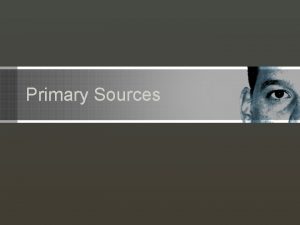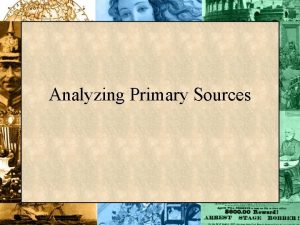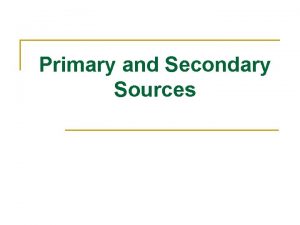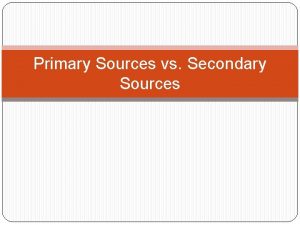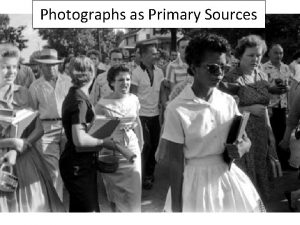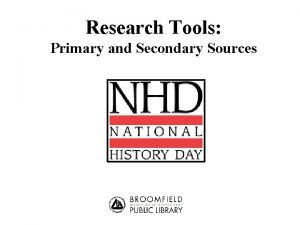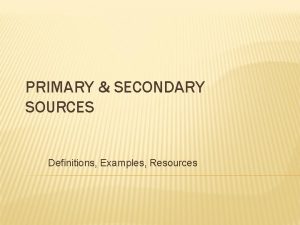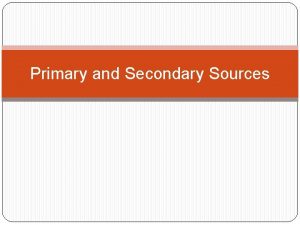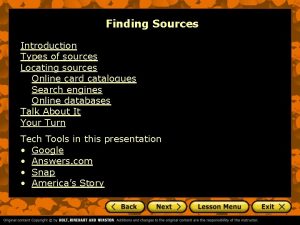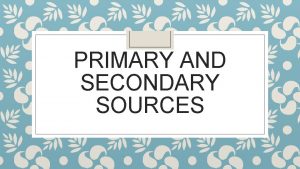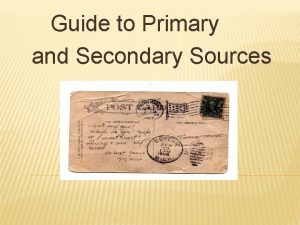Finding Sources Introduction Primary and secondary sources Types





















- Slides: 21

Finding Sources Introduction Primary and secondary sources Types of sources Locating sources Talk About It Your Turn Tech Tools in this presentation • Search engines • Soople • American Memory Collection

Introduction Now that you have your research questions, how do you find the information you need? There are many ways to track down useful sources of information. Discovering these methods is the key to your search.

Primary and secondary sources The most basic way to categorize any source in research is as a primary source or a secondary source. A primary source is firsthand, original information by someone who participated in the event being researched. A secondary source is information derived from or about primary sources.

Primary and secondary sources Primary sources are original documents. Declaration of Independence Photograph of Abraham Lincoln as seen on $5 dollar bill. A published piece such as a newspaper or magazine article is considered primary if written soon after the fact and not as a historical account.

Primary and secondary sources Secondary sources are at least one step removed from the event under review. They interpret, assign values to, conjecture upon, and draw conclusions about the events reported in primary sources. DVD offering of PBS documentary Article Book

Primary and secondary sources Is each source below primary or secondary? a slave diary magazine articles about the Civil War a recording of an African American spiritual a biography of Harriet Tubman a photograph of an abolitionist Primary Sources diary recording photograph Secondary Sources articles about the Civil War biography

Types of sources There are many types of primary and secondary sources available. Below are more examples. Primary Secondary • Books • Original artwork • Biographies • Political posters • Historic film • Pamphlets • Interviews • Personal narratives • Musical compositions • Lyrics • Critiques • Journal articles • Dissertation • Renditions

Types of sources Nondigital Another way to categorize types of sources is as digital or nondigital. Digital sources are anything that can be accessed or viewed using a computer. Nondigital sources are • books • government documents • maps • videotapes • sound recordings • music scores You can use library catalogues, search engines, databases, and so on to locate nondigital sources, but to view them, you have to get an actual physical copy.

Types of sources Digital The key to locating relevant digital sources is to know how to search for information by using the computer and the Internet. Access library databases Browse Internet sites identified by librarians in Research Guides Use subject directories Use search engines Learn advanced search techniques

Locating sources How do you locate sources of information? Believe it or not, even in the world of technology, a great place to start is your school or public library.

Locating sources Libraries make locating sources easy with an online card catalogue, a collection of information about every resource that a system of libraries owns. Most libraries have special computers for searching their online catalogues. Many also offer free Internet access.

Tech Tool: Search Engines Search engines are online tools for locating Internet sources. They search the Web for relevant information based on keywords you select. If you enter several words, a search engine will treat each word as a separate keyword. If you put key words in quotation marks, the search engine will locate sources that contain exactly those words.

Search engines are a great way to locate many digital sources quickly. Because different search engines offer different features, you need to test out a few. (dogpile) © 2008 Info. Space, Inc. All rights reserved. Tech Tool: Search Engines (Yahoo! Search) Reproduced with permission of Yahoo! Inc. © 2008 by Yahoo! and the Yahoo! logo are trademarks of Yahoo! Inc.

Tech Tool: Soople is a fast and easy way to use the advanced features of Google. You can specify a search by file type, media, or a particular site. You can also search scholarly journals.

Locating sources Online databases are collections of records or information that allow you access to the deep Web (or “invisible Web”). The deep Web contains sources that, unlike typical sites, are not found by a regular search engine. Databases manage these hidden sources much like a filing cabinet, and you can search the database for your topic.

Tech Tool: American Memory Collection The American Memory collection is a free, public database provided by the Library of Congress. It was created to capture America’s “memory” through historical documents, moving images, sound recordings, and print and photographic media.

Tech Tool: American Memory Collection The collection allows you to search in many sources for digitized information on your topic, such as written or spoken word sound recordings still and moving images photographs maps sheet music

Tech Tool: American Memory Collection Browsing makes locating primary sources easy. You can browse by collection, time period, or geographical location. You can then search within a collection for your specific topic and select a source you want to view.

Talk About It Discuss these questions with your classmates. 1. Which types of sources listed at the beginning of this lesson have you used before? Why did you choose that type of source? Was it helpful? 2. What types of primary and secondary sources have you used before? How did you locate them? How did you use them? 3. Have you ever used a database? What databases are available to you through your school library? 4. After viewing this presentation, what are some new ways you will look for sources?

Your Turn On a computer, follow these directions: 1. Choose a specific topic. Using Soople, find the following types of sources related to the topic: • a Power. Point presentation • an image • a PDF 2. Add the term database to your search and list the top two responses on your paper.

The End
 Primary secondary and tertiary sources
Primary secondary and tertiary sources Secondary sources
Secondary sources What are the primary and secondary source of light
What are the primary and secondary source of light Similarities of primary and secondary sources venn diagram
Similarities of primary and secondary sources venn diagram It is the primary source of light
It is the primary source of light Levels of care primary secondary tertiary
Levels of care primary secondary tertiary Finding reliable internet sources
Finding reliable internet sources Print and web sources
Print and web sources Sparta primary sources
Sparta primary sources Imp of water resources
Imp of water resources Primary and secondary effects of a tectonic hazard
Primary and secondary effects of a tectonic hazard Primary secondary stakeholders
Primary secondary stakeholders Trees
Trees Primary volcanic hazards
Primary volcanic hazards Use case primary and secondary actors
Use case primary and secondary actors Use case primary and secondary actors
Use case primary and secondary actors Why transformer called static device
Why transformer called static device Tsh
Tsh Primary and secondary retroperitoneal organs
Primary and secondary retroperitoneal organs Difference between primary and secondary succesion
Difference between primary and secondary succesion Oxidation of tertiary alcohol
Oxidation of tertiary alcohol Software
Software














